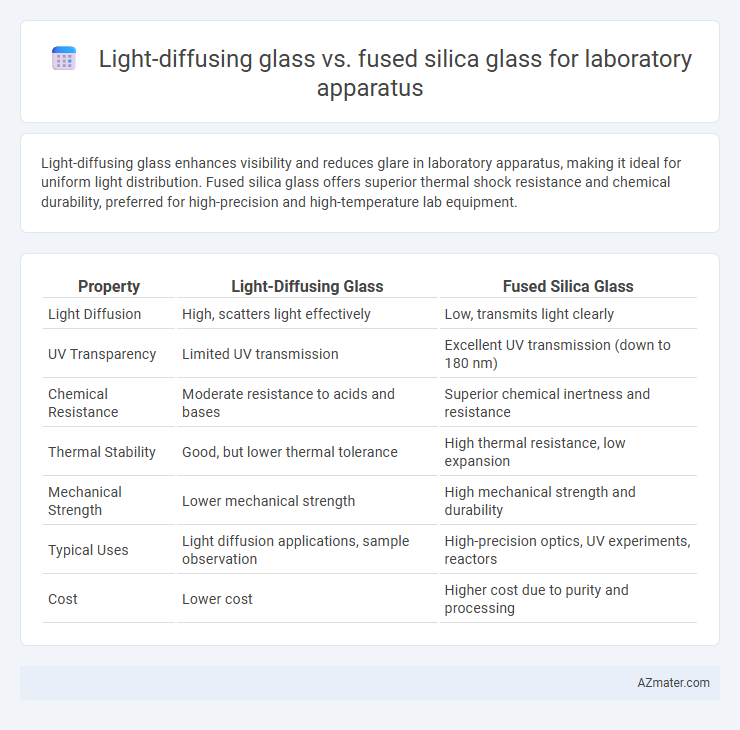Light-diffusing glass enhances visibility and reduces glare in laboratory apparatus, making it ideal for uniform light distribution. Fused silica glass offers superior thermal shock resistance and chemical durability, preferred for high-precision and high-temperature lab equipment.
Table of Comparison
| Property | Light-Diffusing Glass | Fused Silica Glass |
|---|---|---|
| Light Diffusion | High, scatters light effectively | Low, transmits light clearly |
| UV Transparency | Limited UV transmission | Excellent UV transmission (down to 180 nm) |
| Chemical Resistance | Moderate resistance to acids and bases | Superior chemical inertness and resistance |
| Thermal Stability | Good, but lower thermal tolerance | High thermal resistance, low expansion |
| Mechanical Strength | Lower mechanical strength | High mechanical strength and durability |
| Typical Uses | Light diffusion applications, sample observation | High-precision optics, UV experiments, reactors |
| Cost | Lower cost | Higher cost due to purity and processing |
Introduction to Laboratory Glass Materials
Light-diffusing glass enhances visibility by scattering light uniformly, making it ideal for applications requiring even illumination in laboratory apparatus. Fused silica glass offers superior thermal stability, high chemical resistance, and exceptional optical clarity, making it a preferred choice for precision instruments and high-temperature processes. Both materials serve distinct roles in laboratory settings, with light-diffusing glass optimizing visibility and fused silica glass ensuring durability and performance under extreme conditions.
What is Light-Diffusing Glass?
Light-diffusing glass is engineered to scatter light uniformly, creating a soft, even illumination ideal for reducing glare and enhancing visual clarity in laboratory apparatus. Unlike fused silica glass, which is valued for its exceptional thermal stability and chemical resistance with high UV transmission, light-diffusing glass optimizes light diffusion properties for applications requiring controlled light distribution. This type of glass is essential in environments where precise light management improves the accuracy of optical measurements and experimental observations.
What is Fused Silica Glass?
Fused silica glass is a high-purity material made from silicon dioxide with exceptional thermal stability, chemical resistance, and optical clarity, making it ideal for precise laboratory apparatus. Unlike light-diffusing glass, fused silica offers superior transmission of ultraviolet and infrared light, ensuring minimal distortion and maximum accuracy in scientific experiments. Its low thermal expansion coefficient and high melting point allow it to withstand extreme temperature changes, enhancing durability in demanding lab environments.
Optical Properties Comparison
Light-diffusing glass exhibits high scattering properties that evenly disperse light, enhancing visibility in laboratory setups requiring diffuse illumination. Fused silica glass offers superior optical clarity, low light absorption, and exceptional UV transparency, making it ideal for precise spectroscopic applications. The choice between the two depends on the need for controlled light diffusion versus maximum transmission and minimal distortion in optical measurements.
Chemical Resistance and Durability
Light-diffusing glass offers moderate chemical resistance and durability, suitable for general lab applications but vulnerable to strong acids and alkalis. Fused silica glass exhibits exceptional chemical resistance and durability, resisting most corrosive substances and thermal shock, making it ideal for demanding laboratory environments. Its superior purity and structural integrity ensure longevity and reliable performance in harsh chemical conditions.
Thermal Stability and Heat Resistance
Light-diffusing glass offers moderate thermal stability, suitable for applications requiring uniform light distribution under controlled temperature conditions but may degrade at high heat levels above 300degC. Fused silica glass exhibits exceptional thermal stability and heat resistance, maintaining structural integrity and optical clarity at temperatures exceeding 1000degC, making it ideal for high-temperature laboratory apparatus. Its low thermal expansion coefficient minimizes stress and cracking during rapid temperature changes, outperforming light-diffusing glass in demanding thermal environments.
Light Transmission and Diffusion Efficiency
Light-diffusing glass demonstrates superior diffusion efficiency by evenly scattering light, reducing glare and enhancing visibility in laboratory apparatus, while maintaining moderate light transmission levels. Fused silica glass offers exceptional light transmission above 90%, with minimal diffusion, making it ideal for applications requiring high optical clarity and precise light passage. Selecting between these materials depends on the balance between diffusion needs and maximum light throughput essential for specific laboratory procedures.
Applications in Laboratory Settings
Light-diffusing glass enhances uniform illumination in optical experiments and photographic equipment by scattering light evenly, reducing glare and hotspots. Fused silica glass offers superior chemical resistance and thermal stability, making it ideal for high-temperature reactions, UV spectroscopy, and precise analytical instruments. Both materials serve critical roles in laboratory apparatus, with light-diffusing glass optimizing light distribution and fused silica ensuring durability and optical clarity under harsh experimental conditions.
Cost and Availability Considerations
Light-diffusing glass typically costs less than fused silica glass due to simpler manufacturing processes and broader availability from multiple suppliers, making it a budget-friendly choice for many standard laboratory apparatus. Fused silica glass, prized for its superior thermal stability, chemical resistance, and optical clarity, commands a higher price and may face limited availability depending on regional suppliers and production capacity. Laboratories balancing cost constraints with performance requirements often select light-diffusing glass when advanced optical properties of fused silica are not critical.
Choosing the Right Glass for Laboratory Apparatus
Light-diffusing glass offers enhanced visibility and uniform illumination by scattering light, making it ideal for optical experiments requiring consistent light distribution. Fused silica glass provides superior thermal resistance, chemical inertness, and high UV transmission, making it suitable for high-temperature reactions and spectroscopic applications. Selecting the right glass depends on the laboratory apparatus' specific needs, balancing optical clarity and durability against experimental conditions.

Infographic: Light-diffusing glass vs Fused silica glass for Laboratory apparatus
 azmater.com
azmater.com